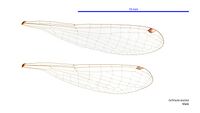Biology:Ischnura aurora
| Golden dartlet | |
|---|---|

| |
| male | |
| Scientific classification | |
| Domain: | Eukaryota |
| Kingdom: | Animalia |
| Phylum: | Arthropoda |
| Class: | Insecta |
| Order: | Odonata |
| Suborder: | Zygoptera |
| Family: | Coenagrionidae |
| Genus: | Ischnura |
| Species: | I. aurora
|
| Binomial name | |
| Ischnura aurora | |
</ref>
| range_map = Ischnura aurora distribution map.svg | synonyms =
- Agrion aurora Brauer, 1865[2]
- Agrion spinicauda Brauer, 1865[2]
- Ischnura bhimtalensis Sahni, 1965[3]
- Ischnura delicata Hagen, 1876[4]:284
- Ischnura rhodosoma Lieftinck, 1959[5]
}}
Ischnura aurora,[1][6] the gossamer damselfy or golden dartlet and also known as the aurora bluetail,[7] is a species of damselfly in the family Coenagrionidae.[1][8]
Adults
A small apple green damselfly with black thoracic stripes and blue tipped yellow tail.[1]
Male
Eyes: Black half moon-like cap above, olive green to dark olive below, which fades to pale olive beneath. Two azure blue spots are present behind the eyes. Thorax: Shining black with two pale grass green stripes; sides are light green and white below. Legs: Pale greenish white with a vertical stripe on the femur, just above the femur - tibia joint. Wings: Transparent. Wing spots: The wing spots are different in fore and hindwings, being rose-red on the forewings and uniform pale grey on the hindwings. Abdomen: Bright reddish yellow. The upper parts of the second and seventh segments have narrow and broad black marks, respectively.[1] A third of the length of the eighth segment and the full length of the ninth segment are blue. The base color of the eighth segment tergite is melanic black.[9]
Female
Eyes: Brown half moon-like cap above, green to pale green below. Thorax: Shining black with two orange stripes; sides are pale green. Legs: Pale white with vertical black stripes on femur, just above femur - tibia joint. Abdomen: A broad black stripe runs along the upper side of abdomen. The eight to tenth segments do not have azure blue markings.[1]
Habitat
Found among vegetation along the banks of ponds, rivers, canals, marshes and wet rice fields.[1]
Distribution
It is found across Australia , the Pacific Islands, East Asia and Southeast Asia.[1] There are strong differences in DNA between the Asian forms of the species and specimens from the Pacific.[1] The form found on the Indian subcontinent and in Iran is Ischnura aurora rubilio (Selys, 1876[4]) and is now considered a different taxon, Ischnura rubilio.[10]
Gallery
See also
- List of Odonata species of Australia
References
- ↑ 1.0 1.1 1.2 1.3 1.4 1.5 1.6 1.7 1.8 Dow, R.A.; Rowe, R.; Marinov, M. (2020). "Ischnura aurora". IUCN Red List of Threatened Species 2020: e.T167375A83371053. doi:10.2305/IUCN.UK.2020-1.RLTS.T167375A83371053.en. https://www.iucnredlist.org/species/167375/83371053. Retrieved 2023-01-14.
- ↑ 2.0 2.1 Cite error: Invalid
<ref>tag; no text was provided for refs namedBrauer - ↑ Sahni, D. N. (1965). "Studies on the Odonata (Zygoptera) of Nainital". Indian Journal of Entomology 27 (2): 205–216.
- ↑ 4.0 4.1 de Selys Longchamps, Edm. (1876). "Le grand genre Agrion. Synopsis des Agrionines. Suite de la 5me Légion: Agrion". Bulletins de l'Académie royale des sciences, des lettres et des beaux-arts de Belgique [Bulletins of the Royal Academy of Sciences, Letters and Fine Arts of Belgium]. 2 41: 247–322, 496–539, 1233–1309 (separate pagination 1–199). https://www.biodiversitylibrary.org/page/5699375. Retrieved 2023-01-16.
- ↑ Lieftinck, M. A. (1959). "On the New Guinea species of Ischnura Charpentier and Oreagrion Ris, with special reference to the larval forms and notes on the species of adjacent regions (Odonata, Coenagrionidae)". Nova Guinea. New Series 10: 213–240.
- ↑ Schorr, Martin; Paulson, Dennis. "World Odonata List". Slater Museum of Natural History. https://www.pugetsound.edu/academics/academic-resources/slater-museum/biodiversity-resources/dragonflies/world-odonata-list2/.
- ↑ Theischinger, Günther; Hawking, John (2006). The Complete Field Guide to Dragonflies of Australia. Collingwood, Vic.: CSIRO Publishing. p. 96. ISBN 978-0643090736. https://books.google.com/books?id=_ega6FdnwZ0C&pg=PA96.
- ↑ "Species Ischnura aurora (Brauer, 1865)". Australian Biological Resources Study. 2022-05-10. https://biodiversity.org.au/afd/taxa/Ischnura_aurora.
- ↑ Rowe, R. J. (2010-08-13). "Ischnura aurora (Brauer 1865) (Zygoptera: Coenagrionidae), an Australo-Pacific species". New Zealand Journal of Zoology 37 (2): 189–192. doi:10.1080/03014223.2010.488789. https://www.tandfonline.com/doi/epdf/10.1080/03014223.2010.488789. Retrieved 2023-01-16.
- ↑ Dumont, H. J. (2013-12-01). "Phylogeny of the genus Ischnura, with emphasis on the old world taxa (Zygoptera: Coenagrionidae)". Odonatologica 41 (4): 301–308. https://odonatologica.files.wordpress.com/2014/08/42-43.pdf. Retrieved 2023-01-16.
External links
Wikidata ☰ Q2221736 entry
 |






